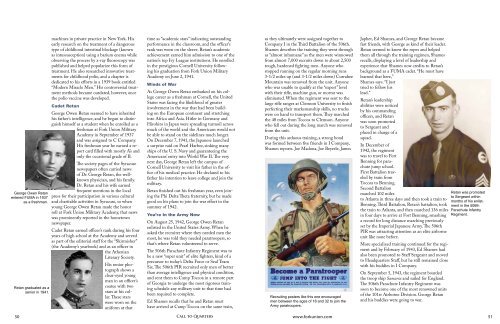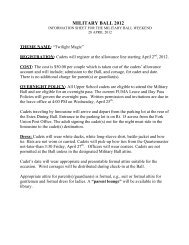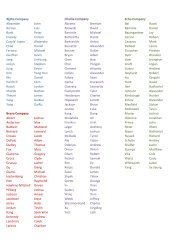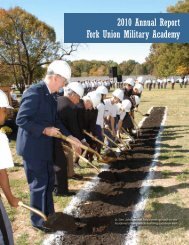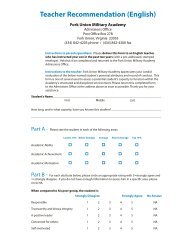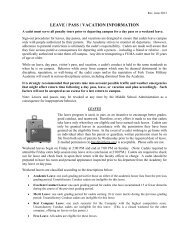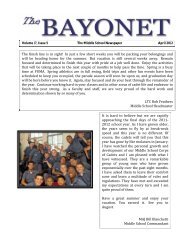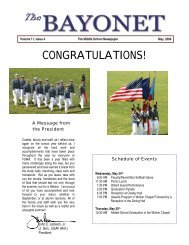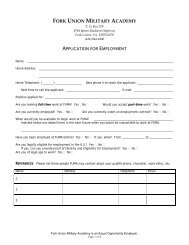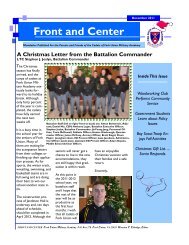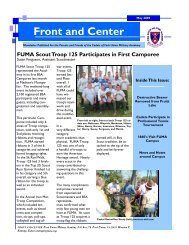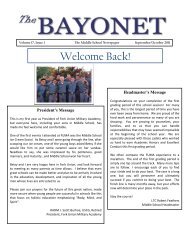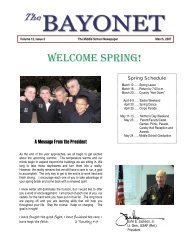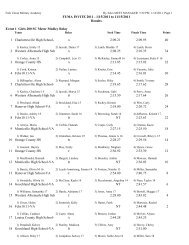The Retan Rifles - Fork Union Military Academy
The Retan Rifles - Fork Union Military Academy
The Retan Rifles - Fork Union Military Academy
Create successful ePaper yourself
Turn your PDF publications into a flip-book with our unique Google optimized e-Paper software.
George Owen <strong>Retan</strong><br />
entered FUMA in 1937<br />
as a freshman.<br />
<strong>Retan</strong> graduated as a<br />
senior in 1941.<br />
machines in private practice in New York. His<br />
early research on the treatment of a dangerous<br />
type of childhood intestinal blockage (known<br />
as intussusception) using a barium enema while<br />
observing the process by x-ray fluoroscopy was<br />
published and helped popularize this form of<br />
treatment. He also researched innovative treatments<br />
for childhood polio, and a chapter is<br />
dedicated to his efforts in a 1939 book entitled<br />
“Modern Miracle Men.” His controversial treatment<br />
methods became outdated, however, once<br />
the polio vaccine was developed.<br />
Cadet <strong>Retan</strong><br />
George Owen <strong>Retan</strong> seemed to have inherited<br />
his father’s intelligence, and he began to distinguish<br />
himself as a student when he enrolled as a<br />
freshman at <strong>Fork</strong> <strong>Union</strong> <strong>Military</strong><br />
<strong>Academy</strong> in September of 1937<br />
and was assigned to C Company.<br />
His freshman year he earned a report<br />
card filled with mostly A’s and<br />
only the occasional grade of B.<br />
<strong>The</strong> society pages of the Syracuse<br />
newspapers often carried news<br />
of Dr. George <strong>Retan</strong>, the wellknown<br />
physician, and his family.<br />
Dr. <strong>Retan</strong> and his wife earned<br />
frequent mentions in the local<br />
press for their participation in various cultural<br />
and charitable activities in Syracuse, so when<br />
young George Owen <strong>Retan</strong> made the honor<br />
roll at <strong>Fork</strong> <strong>Union</strong> <strong>Military</strong> <strong>Academy</strong>, that news<br />
was prominently reported in the hometown<br />
newspaper.<br />
Cadet <strong>Retan</strong> earned officer’s rank during his four<br />
years of high school at the <strong>Academy</strong> and served<br />
as part of the editorial staff for the “Skirmisher”<br />
(the <strong>Academy</strong>’s yearbook) and as an officer in<br />
the Athenian<br />
Literary Society.<br />
His senior photograph<br />
shows a<br />
clear-eyed young<br />
man in an officer’s<br />
coatee with two<br />
stars at his collar.<br />
<strong>The</strong>se stars<br />
were worn on the<br />
uniform at that<br />
time as “academic stars” indicating outstanding<br />
performance in the classroom, and the officer’s<br />
rank was worn on the sleeve. <strong>Retan</strong>’s academic<br />
achievement earned him admission to one of the<br />
nation’s top Ivy League institutions. He enrolled<br />
in the prestigious Cornell University following<br />
his graduation from <strong>Fork</strong> <strong>Union</strong> <strong>Military</strong><br />
<strong>Academy</strong> on June 2, 1941.<br />
Winds of War<br />
As George Owen <strong>Retan</strong> embarked on his college<br />
career as a freshman at Cornell, the United<br />
States was facing the likelihood of greater<br />
involvement in the war that had been building<br />
on the European continent and stretching<br />
into Africa and Asia. Hitler in Germany and<br />
Hirohito in Japan were spreading turmoil across<br />
much of the world and the Americans would not<br />
be able to stand on the sidelines much longer.<br />
On December 7, 1941, the Japanese launched<br />
a surprise raid on Pearl Harbor, sinking many<br />
ships of the U. S. Navy and guaranteeing the<br />
Americans’ entry into World War II. <strong>The</strong> very<br />
next day, George <strong>Retan</strong> left the campus of<br />
Cornell University to visit his father in the office<br />
of his medical practice. He declared to his<br />
father his intention to leave college and join the<br />
military.<br />
<strong>Retan</strong> finished out his freshman year, even joining<br />
the Phi Delta <strong>The</strong>ta fraternity, but he made<br />
good on his plans to join the war effort in the<br />
summer of 1942.<br />
You’re In the Army Now<br />
On August 25, 1942, George Owen <strong>Retan</strong><br />
enlisted in the United States Army. When he<br />
asked the recruiter where they needed men the<br />
most, he was told they needed paratroopers, so<br />
that’s where <strong>Retan</strong> volunteered to serve.<br />
<strong>The</strong> 506th Parachute Infantry Regiment was to<br />
be a new “super unit” of elite fighters, kind of a<br />
precursor to today’s Delta Force or Seal Team<br />
Six. <strong>The</strong> 506th PIR recruited only men of better<br />
than average intelligence and physical condition,<br />
and sent them to Camp Toccoa in a remote part<br />
of Georgia to undergo the most rigorous training<br />
schedule any military unit to that time had<br />
been required to complete.<br />
Ed Shames recalls that he and <strong>Retan</strong> must<br />
have arrived at Camp Toccoa on the same train,<br />
as they ultimately were assigned together to<br />
Company I in the Third Battalion of the 506th.<br />
Shames describes the training they went through<br />
as “almost inhumane” as the men were winnowed<br />
from almost 7,000 recruits down to about 2,500<br />
tough, hardened fighting men. Anyone who<br />
stopped running on the regular morning runs<br />
3-1/2 miles up (and 3-1/2 miles down) Currahee<br />
Mountain was removed from the unit. Anyone<br />
who was unable to qualify at the “expert” level<br />
with their rifle, machine gun, or mortar was<br />
eliminated. When the regiment was sent to the<br />
large rifle ranges at Clemson University to finish<br />
perfecting their marksmanship skills, no trucks<br />
were on hand to transport them. <strong>The</strong>y marched<br />
the 48 miles from Toccoa to Clemson. Anyone<br />
who fell out during the long march was removed<br />
from the unit.<br />
During this arduous training, a strong bond<br />
was formed between five friends in I Company,<br />
Shames reports. Joe Madona, Joe Beyerle, James<br />
Recruiting posters like this one encouraged<br />
men between the ages of 18 and 32 to join the<br />
Army paratroopers.<br />
Japhet, Ed Shames, and George <strong>Retan</strong> became<br />
fast friends, with George as kind of their leader.<br />
<strong>Retan</strong> seemed to know the ropes and helped<br />
them all through the training regimen, Shames<br />
recalls, displaying a level of leadership and<br />
experience that Shames now credits to <strong>Retan</strong>’s<br />
background as a FUMA cadet. “He must have<br />
learned that here,”<br />
Shames says. “I just<br />
tried to follow his<br />
lead.”<br />
<strong>Retan</strong>’s leadership<br />
abilities were noticed<br />
by his commanding<br />
officers, and <strong>Retan</strong><br />
was soon promoted<br />
to Sergeant and<br />
placed in charge of a<br />
squad.<br />
In December of<br />
1942, the regiment<br />
was to travel to Fort<br />
Benning for parachute<br />
jump school.<br />
First Battalion traveled<br />
by train from<br />
Toccoa to Benning.<br />
Second Battalion<br />
marched 102 miles<br />
to Atlanta in three days and then took a train to<br />
Benning. Third Battalion, <strong>Retan</strong>’s battalion, took<br />
the train to Atlanta, and then marched 136 miles<br />
in four days to arrive at Fort Benning, smashing<br />
a record for long distance marching previously<br />
set by the Imperial Japanese Army. <strong>The</strong> 506th<br />
PIR was attracting attention as an elite airborne<br />
unit like none before.<br />
More specialized training continued for the regiment<br />
and by February of 1943, Ed Shames had<br />
also been promoted to Staff Sergeant and moved<br />
to Headquarters Staff, but he still remained close<br />
with his buddies in I Company.<br />
On September 5, 1943, the regiment boarded<br />
the troop ship Samaria and sailed for England.<br />
<strong>The</strong> 506th Parachute Infantry Regiment was<br />
soon to become one of the most renowned units<br />
of the 101st Airborne Division. George <strong>Retan</strong><br />
and his buddies were going to war.<br />
<strong>Retan</strong> was promoted<br />
to Sergeant within<br />
months of his enlistment<br />
in the 506th<br />
Parachute Infantry<br />
Regiment.<br />
50 Call to Quarters www.forkunion.com 51


